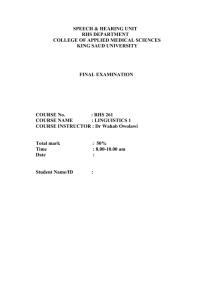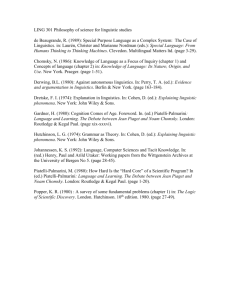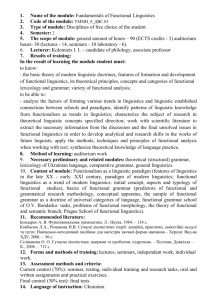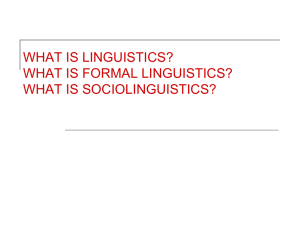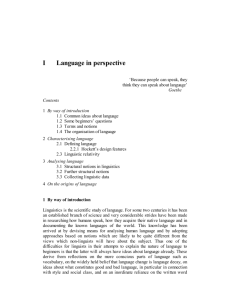Key Concepts: Unit 3 – Language and Society Accent: Version of
advertisement
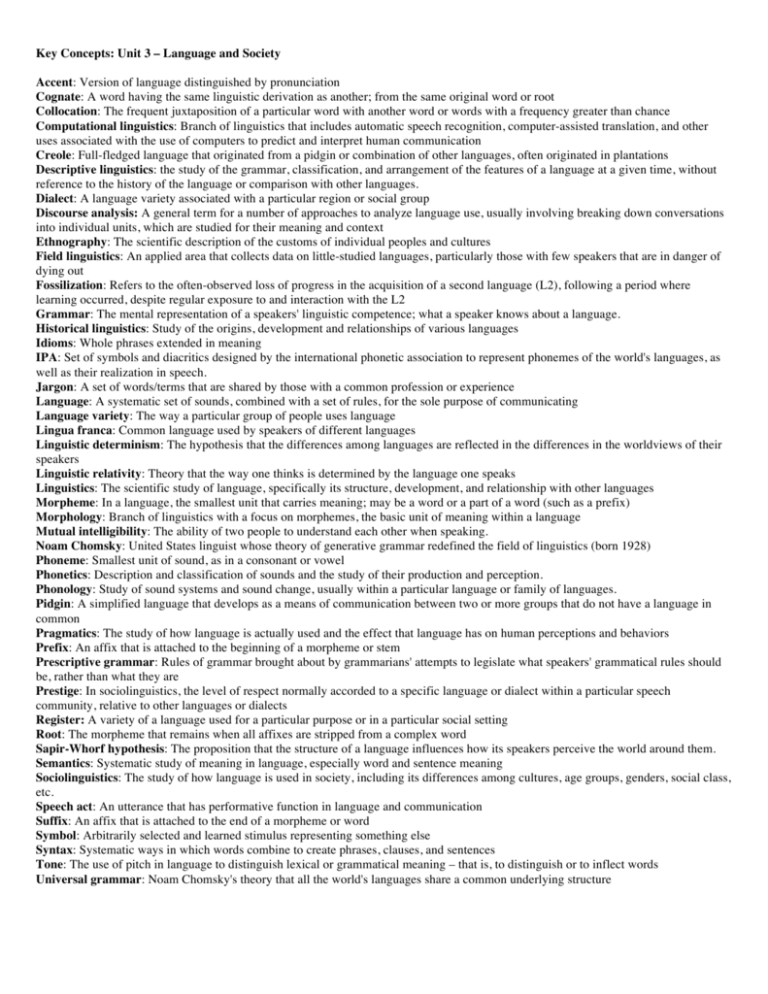
Key Concepts: Unit 3 – Language and Society Accent: Version of language distinguished by pronunciation Cognate: A word having the same linguistic derivation as another; from the same original word or root Collocation: The frequent juxtaposition of a particular word with another word or words with a frequency greater than chance Computational linguistics: Branch of linguistics that includes automatic speech recognition, computer-assisted translation, and other uses associated with the use of computers to predict and interpret human communication Creole: Full-fledged language that originated from a pidgin or combination of other languages, often originated in plantations Descriptive linguistics: the study of the grammar, classification, and arrangement of the features of a language at a given time, without reference to the history of the language or comparison with other languages. Dialect: A language variety associated with a particular region or social group Discourse analysis: A general term for a number of approaches to analyze language use, usually involving breaking down conversations into individual units, which are studied for their meaning and context Ethnography: The scientific description of the customs of individual peoples and cultures Field linguistics: An applied area that collects data on little-studied languages, particularly those with few speakers that are in danger of dying out Fossilization: Refers to the often-observed loss of progress in the acquisition of a second language (L2), following a period where learning occurred, despite regular exposure to and interaction with the L2 Grammar: The mental representation of a speakers' linguistic competence; what a speaker knows about a language. Historical linguistics: Study of the origins, development and relationships of various languages Idioms: Whole phrases extended in meaning IPA: Set of symbols and diacritics designed by the international phonetic association to represent phonemes of the world's languages, as well as their realization in speech. Jargon: A set of words/terms that are shared by those with a common profession or experience Language: A systematic set of sounds, combined with a set of rules, for the sole purpose of communicating Language variety: The way a particular group of people uses language Lingua franca: Common language used by speakers of different languages Linguistic determinism: The hypothesis that the differences among languages are reflected in the differences in the worldviews of their speakers Linguistic relativity: Theory that the way one thinks is determined by the language one speaks Linguistics: The scientific study of language, specifically its structure, development, and relationship with other languages Morpheme: In a language, the smallest unit that carries meaning; may be a word or a part of a word (such as a prefix) Morphology: Branch of linguistics with a focus on morphemes, the basic unit of meaning within a language Mutual intelligibility: The ability of two people to understand each other when speaking. Noam Chomsky: United States linguist whose theory of generative grammar redefined the field of linguistics (born 1928) Phoneme: Smallest unit of sound, as in a consonant or vowel Phonetics: Description and classification of sounds and the study of their production and perception. Phonology: Study of sound systems and sound change, usually within a particular language or family of languages. Pidgin: A simplified language that develops as a means of communication between two or more groups that do not have a language in common Pragmatics: The study of how language is actually used and the effect that language has on human perceptions and behaviors Prefix: An affix that is attached to the beginning of a morpheme or stem Prescriptive grammar: Rules of grammar brought about by grammarians' attempts to legislate what speakers' grammatical rules should be, rather than what they are Prestige: In sociolinguistics, the level of respect normally accorded to a specific language or dialect within a particular speech community, relative to other languages or dialects Register: A variety of a language used for a particular purpose or in a particular social setting Root: The morpheme that remains when all affixes are stripped from a complex word Sapir-Whorf hypothesis: The proposition that the structure of a language influences how its speakers perceive the world around them. Semantics: Systematic study of meaning in language, especially word and sentence meaning Sociolinguistics: The study of how language is used in society, including its differences among cultures, age groups, genders, social class, etc. Speech act: An utterance that has performative function in language and communication Suffix: An affix that is attached to the end of a morpheme or word Symbol: Arbitrarily selected and learned stimulus representing something else Syntax: Systematic ways in which words combine to create phrases, clauses, and sentences Tone: The use of pitch in language to distinguish lexical or grammatical meaning – that is, to distinguish or to inflect words Universal grammar: Noam Chomsky's theory that all the world's languages share a common underlying structure Variation: A characteristic of language: there is more than one way of saying the same thing. Speakers may vary pronunciation, word choice, or morphology and syntax


